
Carlotta Collette, and real estate developers Phil
Morford and Konstantin Klebleev cut the ribbon
on the new Milano apartments today.
(Photos © J. Maus/BikePortland)
The ribbon was cut at the new Milano apartments in the Lloyd Center this morning. As people streamed by the newly painted bike lanes on NE Multnomah Street behind them, Metro Councilor Carlotta Collette stood behind a shiny new city bike with the building’s architect Murray Jenkins and developers Phil Morford and Konstantin Klebleev.
On a table in the lobby a brochure enticed would-be buyers to, “Live in Portland’s first thoroughly bike friendly community… Not only is the Milano located with immediate access to public transportation — including the MAX line, Portland streetcar, and TriMet — it’s also at the hub of the city’s cycling lanes.”
According to developer Phil Morford, the entire Milano project was conceived with a focus on being oriented toward the low-car and carfree lifestyle. “When we began to design this project,” Morford said at the grand opening event today, “Our first discussion was with Metro.” As the quintessential “transit-oriented development,” the development of the Milano was aided by a $300,000 Metro grant which leveraged over $13 million in private investment.
While transit was a key to funding the development, it’s the appeal of bicycling that is at the center of the building’s marketing campaign. Asked when we’ll ever see bike-oriented development funding, Metro’s Collette said, “TOD starts with the transit funding stream. Finding the dollars for bicycle specific projects is trickier.” In other words, TOD funds — which are doled out based on a formula of how many new transit riders a development might create — exist because there is a big pot of federal dollars already set-aside for transit. The same pot of money, nor a formula like that, exists for bicycling.
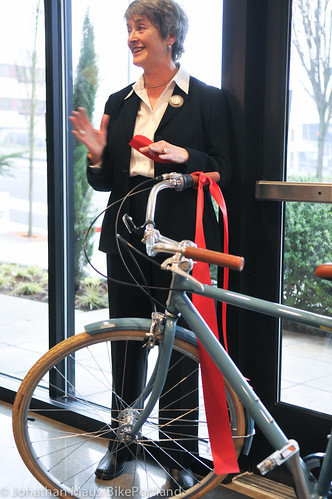
The Milano’s niche is close-in, affordable, workforce housing that caters to bicycle and transit users who don’t own a car. And it would be hard to find a better location. “The goal was to get close to the action, and you cant get more close than here,” commented architect Murray Jenkins as he rattled off all the nearby non-car travel options. The Milano is mere steps away from MAX, bus, bikeways, and even the new eastside streetcar line. At today’s opening celebration, Car2Go reps had a table in the bike parking room.
Units (there are 60 total) at the Milano are small and range in price from $895 for a studio to $1,250 for a one-bedroom. One of the big ways Milano tenants will save money is by not driving. There are only 12 auto parking spaces for the entire building and a permit to park in one of them costs $150 a month. On the other hand, the bike parking is plentiful and it’s absolutely free.
The indoor bike parking at the Milano boasts room for 91 bicycles. It is located directly adjacent to the main lobby (not in a back room) and it has two access doors: one from outside and one leading into the lobby. It is also secured with a key-fob entry (only tenants with bicycles have access) and a security camera. There’s even a repair stand, a pump and some tools.
Phil Morford with Civitas, a real estate development company, said it was his firm that put the bicycle at the center of the building’s marketing push. “We knew it would be near transit, so we didn’t need to make room for as many cars. The bike thing happened almost by default.” The new road diet and redesign of NE Multnomah Street that comes right to Milano’s front door happened after the project had already begun. “That was serendiptous,” Morford said with a big grin, “I think [riding on it] is great. It’s a much safer environment.”
As for the “apartments with no parking” debate, Morford doesn’t see what the big deal is. “If your building is well-served with transit and bike lanes, I don’t see a problem with parking at all.” So far, less than half of the Milano tenants own cars.
And if all goes well, this isn’t the last transit and bike-oriented project we’ll see from these developers. “We’ve already had a huge response from people,” said Phil Horford, “And we want to do this in other places.”
CORRECTION: I initially reported that $300,000 in Metro funds leveraged $13.1 million in federal TOD funding. That was wrong. The correct information is that the Metro funds leveraged $13.1 million in private investment. I regret the error — Jonathan



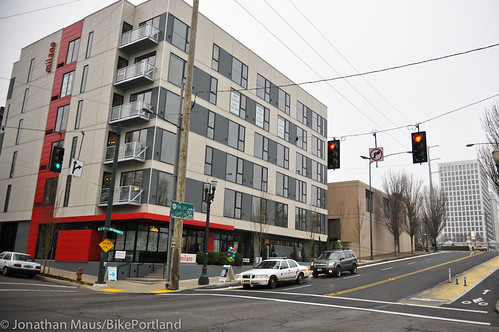
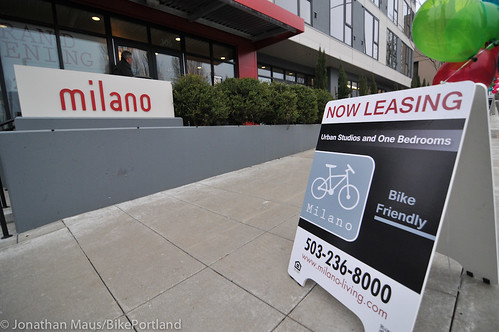
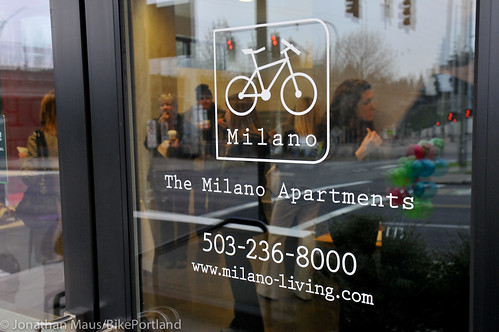
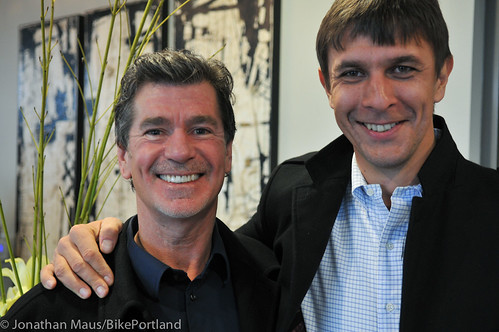



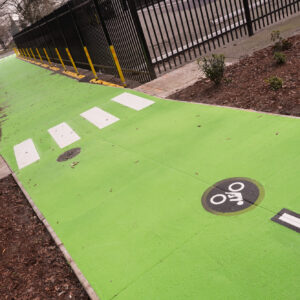
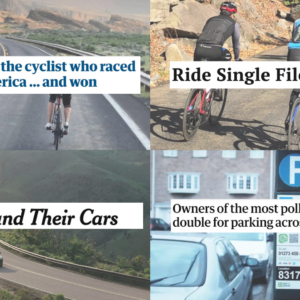

Thanks for reading.
BikePortland has served this community with independent community journalism since 2005. We rely on subscriptions from readers like you to survive. Your financial support is vital in keeping this valuable resource alive and well.
Please subscribe today to strengthen and expand our work.
Fascinating. Great to see so much hard work put into something so sensible.
Too bad about the sea of asphalt out the front door, though.
Looks like the racks will not accept u-locks. Not sure why that decision was made.
Also no on-ground racks? Developers should not assume everyone can lift the bike onto a front-tire hook.
and not everybody wants to risk tweaking their wheel by hanging their bike from it…
What kind of wheels to you have? Ones made out of paper mache?
A bicycle is considerably less massive than its rider, to say nothing of the force of a bump. Fancy carbon rims… you might want to keep that bike in your apartment anwyay.
I’ve also seen bike shops such as Athlete’s Lounge (back when they were in their older, much smaller space) hanging very expensive bikes by their wheels from the ceiling. I imagine they wouldn’t do that unless it was OK for the bike.
how do you hang a cargo bike?
1 ton winch?
Block and tackle pulley system?
Still doesn’t help when the bike is longer than the height of the ceiling like my LWB recumbent cargo bike. AZ calls it the Flying Dutchman, I call if The Truck. Carries about 500 pounds, rides like a limo and is longer than a mid-size car.
Where are the pictures of your “pimp” ride?
Not my bike, but a similar one: http://www.atomiczombie.com/Dutchman%20Full%20Suspension%20Cargo%20Bike.aspx
I don’t understand why no one mentions that for just $1,0560 a month, you can have one of the better located studios with a view of the homeless pissing and shitting right outside your building. Sometimes you get lucky when you’re walking home from the MAX and even catch one masturbating!
Maybe I’m making it up. Or maybe I live next door to this building and know it first hand.
Though, washers/dryers in every apartment do sound nice. But at $900-1050 for a studio, I’d keep shopping.
OMG folks let’s not be so critical about the bike parking hooks. I agree the parking is not ideal, but I can appreciate the amount and quality of space given to indoor bike parking. And just so you know, there is some space in that room without hooks where one could roll in a bike and lean it against the wall and/or use the kickstand without having to lift it up. Also, I’m sure the building managers would be able to unscrew a few of these hooks and install a different type if they had to/were aware of another solution (I’m looking at you scott 😉 ).
Hopefully there are on-ground racks in the area you speak of. I agree that this is a great project in an area that is on its way to being even more of a major bike hub, and I’m glad to see the trend continue.
I’m only critical because I’ve seen too many developers jump into a project without fully thinking about the different condition of people and types of bikes people ride, and opting for inexpensive or incomplete solutions. I do a lot of upgrade/retrofits in buildings like this. I’m sure the developers were very well intentioned, but the result is a little lackluster in my opinion, considering their marketing message.
We should use Bremik’s Central Eastside Lofts (http://livingeastside.com/features.html) as a spectacular example of what very high quality and well thought out bike parking can be (note: I did not work on this project).
But yes, I’d be glad to help them take it up a notch
Scott, you help will be highly appreciated. if you are in the neighborhood, please stop by and leave your contact info. I would be happy to pick your ideas and make them real. we are bikes too, but a lot of times you think of something and miss something else. any input is highly appreciated!
Scott – after reading this article and comments, I took a tour of the Central Eastside Lofts, and I have to say that you are correct about the bike parking. There’s plenty to like about the Milano, but Central Eastside Lofts had a few different styles of bike racks (not hooks), the bike room is just off the lobby, requires key fob access and has security cameras, a very well equipped repair station, lockers, and a very cool bike washing station; whoever developed this project put a lot of thought in to it (I was told that Bremik was the contractor but the developer is a smaller local firm). In addition to the bike room, the developer installed dedicated bike storage in most of the units that is a sturdy hook on top of concrete wall board of some sort for durability – which means tenants won’t be forced to store bikes only in the common room. I like the Milano in many ways and the pricing seems better (its hard to compare), but Central Eastside Lofts has a much better location and is extremely well done with finishes and bike parking but seems more costly…but wow.
I have to defend the critics here. One bad choice CAN ruin the whole design. Those hooks make it difficult to lock your bike; therefore the whole room fails in its goal to be a convenient & secure bike parking facility. Therefore the amount of space devoted is suddenly no longer impressive, because it’s unusable space, wasted space (which you nonetheless still have to pay for through your rent). I can’t imagine living there and dealing with that insult daily. Having to leave my bike unlocked, or take it up to my apartment, or buy a huge cable or chain. All the sloppy workarounds to solve a problem that should’ve been solved further upstream.
Why do I say it’s an “insult?” Because with this one omission, all the supposedly good intentions are instantly revealed to be, literally, inconsiderate (“displaying a lack of consideration”). Who would make such an error, to work on something for weeks or months and make a mistake that was apparent to the first commenter here within 9 minutes? If I had to guess or bet, I’d say, someone who hadn’t been on a bike in 20 years, or ever. Someone who ignored or never sought the input of anyone who rides a bike. Someone who thinks “Biking is great!… for YOU morons, but I prefer my Lexus.” In short, someone who doesn’t believe in being “bike friendly” except as a cynical, patronizing marketing ploy with no real meaning.
Not saying all that’s TRUE… either it’s not, and they made a well-intentioned mistake in such a way that unfortunately sends precisely that message, or, it IS true, and they inadvertently tipped their hand.
An analogy: A good samaritan holding a knife looks just like a mugger. If he’s really a good samaritan, he made a mistake by showing the knife and making himself look like a mugger. If he’s a mugger, he made a mistake by showing the knife and making himself look like a mugger.
Get those hooks changed out pronto or the whole thing’s a failure!
How many of them biked to the ribbon-cutting?
I’m with Rol here. I work in a building that has “bike facilities” which includes a secure room with key access to only those that get a key from management. However, some design issues make the bike room underutilized and I would say, remind me that it is an afterthought. To enter the room you have to go UP 4 stairs to get to the loading dock freight elevator, wait for the freight elevator, then go down to the basement, then go DOWN 4 stairs to get to the secure room. Once inside the room, there are great wall racks that accommodate a u-lock however, they DO NOT accommodate fenders….the fender either bends away or gets smooshed against the wheel all day. So, as a result, on my floor alone there are 7 bikes that are hauled up into the offices every day and I know of at least 20 other people in the building that go to other floors with their bike. As a cargo bike rider, I don’t care about the hooks that much, my bike is too long anyway, but it is annoying that I have to schlep my bike up and down stairs everyday both directions. I get that the bike room is great, and came long after the building was built, so I don’t mind (although I would love some of those snazzy bike gutters). Once again, we allow poor planning to make good intentions be only that–intentions. Imagine if they offered parking spaces, but they were all too short for any car except one of those “Fortwo” types. It is likely people would find that a bit absurd.
They should fix this.
For what it’s worth, I sent Murray Jenkins (the principal architect with Ankram Moisan on this project) a link to this comment thread, briefly summarized my concerns, and apologized in advance for my strident tone here. He wrote back a couple hours later to thank me for the comments and to state roughly (sorry, didn’t save the email) as follows:
– They were aware those hooks don’t accommodate a standard 9-inch U-lock, and that cable locks are “not nearly” as secure as U-locks.
– These issues were discussed in project meetings, but the team (including the owner & developer) ultimately decided that the electronic security measures (key-card door access and surveillance camera) would be sufficient to make up for it.
I dunno, to me that sounds like a fancy solution where a simple one would’ve done. What happens when the power goes out? Or when people — as they’re wont to do — allow strangers to tag along into secure areas just to be friendly & helpful? Or when a thief manages to obscure his face from camera view?
But at least they addressed it. And I suppose the upside is that the room is somewhat less cluttered with the smaller hooks.
Jonathan, yes on the surface these rack comments [by your customers] may seem to be ‘nit picky’, but when an architect (or accountant) of a multimillion dollar facility can buy a very secure wall rack for $80 – $120 vs. an insecure rack for $10 – $20 it seems more penny wise and pound foolish from a long term operational sense. (The site manager will end up having to spend more time reporting lost bikes or keeping bikes out of folks apartments/ balconies in the long term with the racks they have chosen.)
This is a long term educational issue [or opportunity] with building owners, architects, and managers. Please forward on my contact information. I would be very willing to help.
Todd Boulanger
VP of Operations
Bikestation
“Just so you know”… Meh.
Come on — it’s just silly that no-one thought to make U-locks work on the racks (see for example the racks in the indoor parking space at the Standard Insurance Center). All it takes is someone to get in there with a set of bolt cutters late at night, and in 15 minutes they roll out with plenty of loot. A for effort, but B- for execution on the locking situation.
http://www.dobradesign.com/delta.php
Get them with only one peg, rather than two. If you can lift your bike, they let you lock both a wheel and the frame.
These small issue aside, which can be worked out overtime, overall this is a wonderful project that can and should be replicated throughout the denser areas of the city. I know that when I was living in apartments this is what I would have been looking for.
bike friendly…but you’ll still own a car
Unless you are referring to the 12 car parking spots, it seems like maybe we should wait and see how this shakes out. Car ownership among renters in recently built buildings that do not include off-street car parking accommodations are the subject of some disagreement, with rates diverging widely depending on who you ask. I think this will get sorted out in time as car ownership ceases to be necessary/viable/desirable and as those of us who currently don’t have cars find ways to move into these buildings.
America’s a big country and people still like to get around. Sometimes they even like to take bikes places. Anyone claiming that most urban condo owners (Portland, Seattle, whatever) aren’t interested in car-enabled recreation is delusional. Lifestyle people need lifestyle toys. If residents can own a car, they will– until the inconvenience reaches SF / NYC levels. Even then, people still own cars. I wish developers would just say “It’s okay to have your cake and eat it too!” rather than marketing their developments under a banner of fake-eco-friendly greenwashing principles. It’s a place to live, and whether or not quite-so-many people will use cars 20 or 30 years from now is beside the point. People use cars today. Let’s build buildings for today, too.
I agree with you about the lifestyle toys, but where do you get the 20 or 30 years bit?
Not-quite-so-many-people are owning and using cars right now. 20 or 30 years is a long way off.
Best security solution I’m aware of is the bike lockers they have around town: http://www.portlandoregon.gov/Transportation/article/58383#Lloyd
I use one in the Lloyd district, and it’s great. I keep a big plastic tub inside with extra clothes, and when I lock my bike inside I don’t have to worry about losing all of the expensive extras off my bike that you can’t protect when you U-lock it (saddle, tool bag, lights, computer, etc). If stores offered this sort of parking, I would shop by bike more. Having a ‘thief-pick-a-bike stand’ out front doesn’t really count as bike-friendly to me.
Developers have a new incentive to build without cars, which allows for cheaper housing options, while also helping with our city’s low vacancy rate – another factor that drives up rent. This a win/win across the board for good urbanism.
$900 for a studio right next to the largest freeway in the western US is not affordable or “workforce.” It’s insulting.
I could care less about the “bike-friendly” apartment accessories. This is a really expensive apartment building in a horrible location where if I were a tenant I’d be unable to open my windows in the spring/summer. Freeway noise, car fumes, bus fumes. I live in a 800 sq ft one floor duplex with a garage, in a good NEIGHBORHOOD and pay less than the studio in that building. Seriously overpriced for a partially publicly funded apartment building next to a freeway.
Bike-lock fiascos aside, this looks like an amazing building! With so many people moving to Portland, it is really important to keep building more attractive, dense urban apartment dwellings on brownfield infill sites. My rent has just gone up fifty bucks yet again this month. There is such a huge demand in the rental market here in Portland, and not enough apartment square footage available to meet it. Love the fact it’s bike and transit-centric too!
Indeed. I’m in a 100 year old building building with no parking and a large bike room in the basement close to the new streetcar line, I feel like I have it too good for my rent NOT to go up. But we shall see. Those mustard colored buffers are appealing it’s hard to turn off Multnomah when your turn comes up.
Maybe I’m missing something, but this building is neither on a brownfield or infill (though it seems everyone has a different definition of what infill means). I’m just not entirely sure what is so special about this building. It has plastic sheeting for siding. And much can be made about the bike spots, but without them the city would require more parking spots, no? Which would have made the entire project too expensive. So we can trumpet the “good” of the developers, but I’m skeptical. It’s just a way to waive the required parking spots and make the project happen.
I’m with the commenter above that asked how many of the architects and developers rode bikes to the building today.
No, the city would *not* require more parking spots. In fact, the city requires zero parking spots in places deemed near good transit. Adding parking to such apartments is entirely up to the developer.
The city does have requirements for bike parking, not sure what they are.
+1 to all the “concerned about hook quality” comments.
The room itself is beautiful. The size of the space is excellent. But it’s not all that great for car-free living.
Good bike facilities will lit you
• lock your bike
• hang it securely with a wheel-friendly hook
• hang your jacket and pants on it to dry overnight(Milano got this one)
• allow low-upper-body-strength folks to park their bikes
• allow trailers to be parked securely
• allow cargo bikes to be parked securely
• have smallish “pods” with separate entry codes so if a klepto moves into the building they can cause less damage
• tool rack, pump
Luckily, this can all be retrofitted into Milano with minimal cost. The bigger problem is in buildings that design zero indoor bike parking at ribbon-cutting time.
Ted Buehler
Excellent points. A few thousand dollars could fix most of those issues.
Incidentally I was just reading about another multi-tenant housing building that was having “issues” with their bike parking after the ownership of the building changed hands, as chronicled here on this site…
$900 for a studio is not affordable or “workforce.”
Is there a website with proper bike parking examples? I would imagine architects need an updated/new Architecture Standards for bike parking. Coming from the architecture realm, I can imagine putting the drawing together on AutoCAD, knowing personally there’s a better way, but when suggesting my ideas to the project manager(s) they say, “We can’t do all that. The client just wants simple bike parking. And architecture standards just show a hook. Draw that.”
If you have trouble hanging your bike due to a low strength/heavy bike scenario.
Hang your bike by the rear wheel.
Grabbing and lifting by the seat tube (between the top tube and seat stays) allows you to get a lot more leverage on it because you’re are not using one hand to fight a turning front wheel handlebar combo.
From what I see on the max alot of people apparently don’t know this.
I’ve heard that rear-wheel hanging is also better for your bike because it doesn’t put unnatural stress on your front forks and headset.
First world problems.
bikewashing
I know they are trying to maximize space available, but the only way I’d leave my bike in a room like that would be if I had my own “mini locker” to stick my bike in, which I could lock with my own padlock, or perhaps use the same key as my apartment.
No matter how “secure”, a shared area like that is only as secure as it’s weakest link. Just ONE person being nice and holding the door open for a stranger can result in many people having bikes ripped off.
I can’t read about this building without thinking of cookies.
All this talk about bike hooks and not a single mention of the atrocious bike symbol in the logo? They’ve obviously never even seen a bike.
I love to read all the negativity in the comments. The world needs so much more of that.
The building has floor to ceiling windows, gorgeous views, stainless steel appliances, washer and dryer in the units, hardwood floors, balconies… You’re looking at a building that is innovative, creative, and up to par with the changing times. I’ve lived in apartments downtown Portland that were several hundred more a month and built in the 1920s. The fact that these are brand new and renting for these prices is awesome.